Fully Functional Miniature Weapon Models Crafted with Exceptional Quality and a Lifetime Service Guarantee
Derringer, Colt, Beretta, Walther: The Iconic Gun Brands Behind Legendary Novels
In the landscape of literature, where the essence of human experience is distilled into words, objects often transcend their physical forms to become potent symbols. Among these, few are as powerful and evocative as firearms, which have been woven into the fabric of many a tale, becoming as iconic as the characters who wield them.
Gun brands like Derringer, Colt, Beretta, and Walther are not just manufacturers on the peripheries of history; they’ve found their way into some of the most legendary novels ever written.
From the thrilling western accounts in Mark Twain’s “Roughing It” to the chilling narratives of Stephen King’s “It”, the echoes of these guns punctuate moments of tension, suspense, and climax. They’ve seen wartime in Philip Kerr’s “Berlin Noir”, and have sent shivers down our spines in Thomas Harris’s “The Silence of the Lambs”.
Before delving deeper into these narratives, it’s essential to understand how these firearms, products of engineering and innovation, have become emblematic anchors in storytelling, binding the tangible world with the intangible emotions and conflicts of our favorite characters. Join us on this journey, as we trace the literary trajectory of these famed gun brands, revealing the stories they’ve shaped and been shaped by.
Remember a few favorite novels where guns shine on par with the main characters:
Roughing It
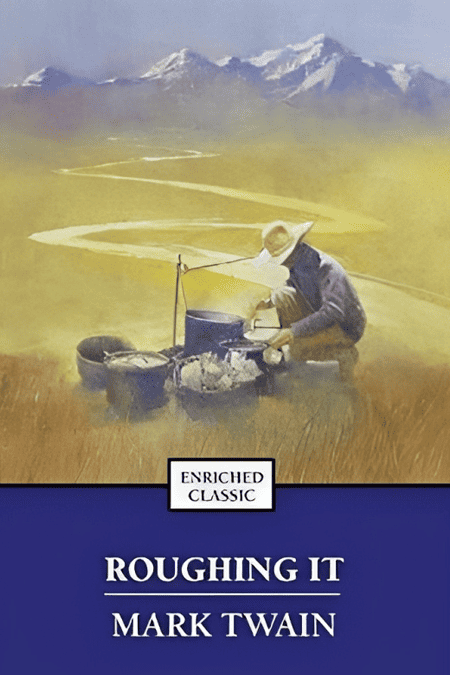
Mark Twain
First published: February 1, 1872
Setting: Overland City, Mount Davidson
Gun: Derringer
“Roughing It” is a semi-autobiographical travel literature book by Mark Twain, published in 1872. This work details Twain’s journey to the American West, covering his travels through Missouri, Nebraska, and Nevada, all the way to California. Twain recounts his experiences in an engaging narrative filled with wit, satire, and colorful characters. The book is known for its vivid descriptions of frontier life, including encounters with Native Americans, miners, entrepreneurs, and a wide array of adventurers seeking fortune or mere survival in the Wild West.
Written in the first person, Twain describes his misadventures and experiences, which range from hilarious to dangerous, as he attempts to navigate the complexities and challenges of frontier living. Though it doesn’t follow a linear plot like a traditional novel, “Roughing It” captures the essence of a transformative period in American history.
In the context of “Roughing It,” the Derringer gun plays a critical role in depicting the lawless, unpredictable atmosphere of the frontier. The quote you provided highlights an incident where a Derringer is used to exert power and control, with Alexander Davis, the Judge of the Court, being held at gunpoint. The scene is intense, with the outcome entirely dependent on the wielder of the Derringer.
The gun, in this instance, serves as a symbol of the balance of power in a place where established laws and norms are often insufficient or disregarded. It’s a microcosm of the broader world Twain portrays, where a mix of desperation, opportunity, and danger make up daily life. Just as the judge “stood perfectly quiet, and offered no resistance,” the role of the Derringer shows how volatile situations could be defused or escalated based entirely on human behavior and the presence of a weapon.
The inclusion of the Derringer in the narrative also lends authenticity to the tale. During the period Twain describes, pocket pistols like the Derringer were common personal weapons, easy to conceal and quick to draw. They were frequently employed in situations requiring immediate and decisive action, which is precisely what happens in the scene with Judge Davis.
We know how much you love these colorful pocket pistols, so we’ve created a variety of options to suit every taste and budget. I will show only a couple of them. First up is our 2mm pinfire Derringer with wood grips. A cool model to start your collection with: simple mechanism and super cute look. The hammer is cocked, the barrel is folded down, the cartridge is inserted. Return the barrel to its original position and pull the trigger for an impressive shot.
You can see it in all its glory here:
I can’t ignore our pride 1mm Derringer. It is almost entirely made of real gold. And you can wear it as a decoration, attracting attention and broadcasting your interests and taste to others. We added Swiss timing springs for the internal mechanism. And we decorated the Derringer with ivory grips to make the model as unique as possible. This Derringer works with 1mm centerfire cartridges. Don’t worry, we also add them to the set. The mechanism is slightly different from the pinfire model. But the action principle is quite simple. Cock, turn the barrel to the side for charging, return to the original position and pull the trigger. Everything is simple, and nevertheless, the shot has an impressive effect. Just look at it:
You can order this amazing miniature gun here:
“Roughing It” is an expansive work that captures the chaos, wonder, and unpredictability of the American West during a time of rapid change. The Derringer gun, as featured in the narrative, serves as a potent symbol of the lawlessness and precariousness that characterized the era. It helps the reader understand the constant tension that hung in the air, a tension that could at any moment tip into violence or quiescence, often dictated by the barrel of a gun.
The story’s treatment of the Derringer encapsulates larger themes of power dynamics, human behavior, and the rough-and-tumble reality of life on the frontier. As such, its inclusion in your article about the role of pistols in famous literary works would offer a compelling examination of how firearms not only reflect but also shape the worlds they inhabit.
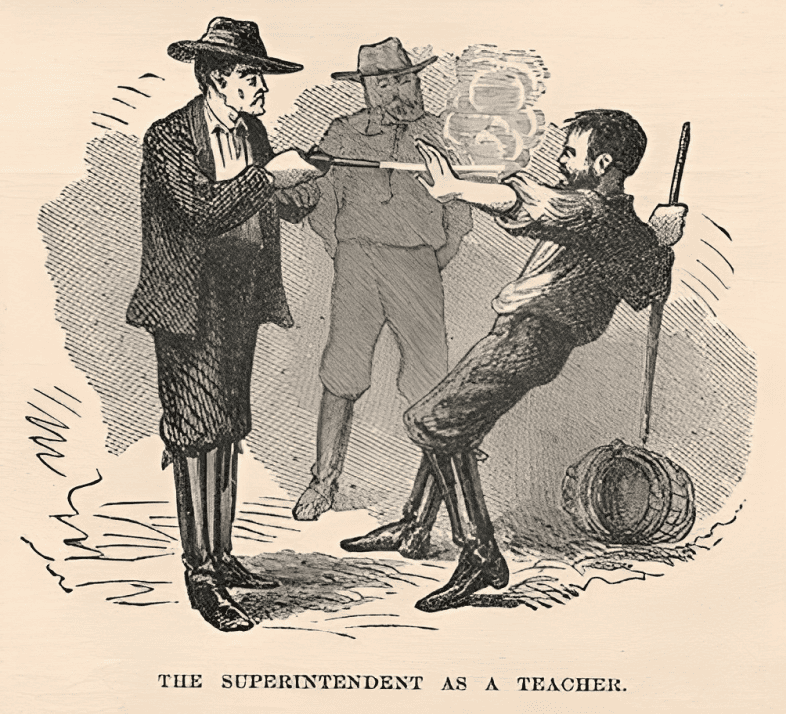
He sought out Alexander Davis, the Judge of the Court, and drawing a cocked Derringer, he presented it at his head, and told him that he should hold him as a hostage for his own safety. As the judge stood perfectly quiet, and offered no resistance to his captor, no further outrage followed on this score.
It

Stephen King
First published: September 15, 1986
Setting: Derry, Maine; New York City; Chicago, Illinois; Los Angeles, California
Gun: Walther
Stephen King’s “It,” published in 1986, is a sprawling horror novel that delves into the lives of seven children in the small town of Derry, Maine. The narrative shifts between two time periods, 1957-58 and 1984-85, focusing on the children’s encounters with a malevolent entity that takes on the form of their worst fears, most often appearing as Pennywise the Dancing Clown. The story is not just a tale of supernatural horror but also an exploration of the traumas, challenges, and friendships that shape childhood and linger into adulthood.
Our ⅓ scale Walther PPK is as exciting as the works of Stephen King, but not as frightening. It works like a slider and shoots impressively with 2mm centerfire ammo. The shots are loud, but look how pretty it is and how delicate it feels in the hand. This contrast is mesmerizing.
In the novel, the seven kids, known as the Losers’ Club, discover that ‘It’ emerges every 27 years to terrorize and kill the children of Derry. United by their outsider statuses and shared experiences of trauma and bullying, the friends vow to destroy the entity. In the later timeline, the Losers’ Club returns to Derry as adults to fulfill their childhood oath and kill ‘It’ once and for all.
The Walther pistol in “It” serves as a concrete symbol of the Losers’ desperate fight against an almost incomprehensible evil. The gun emerges in critical moments, usually at times when the characters face significant internal or external crises. The quote you mentioned, “Richie reached in and caught Bill’s hands in his own. The Walther pistol was in one of them, and for the second time that day Richie looked into its black eye . . . only this time it was loaded,” perfectly encapsulates the intensity and precariousness of the situation.
The “black eye” of the Walther becomes a focal point, a manifestation of the life-or-death stakes at play. In that moment, the characters are forced to confront not just the evil of ‘It,’ but also their own capability for violence and their willingness to use it as a means to an end. The pistol, then, becomes a tool of empowerment but also a reminder of the dangers that come with wielding such power.
Importantly, the gun is not portrayed as a guaranteed solution to their problems. It is, however, a potent symbol of their agency in a world that often leaves them feeling powerless. The Walther serves as one of the ways in which the characters arm themselves against a world filled with real and supernatural terrors.
Stephen King’s “It” is a complex narrative that deals with themes ranging from the traumas of childhood to the existential dread of facing an incomprehensible evil. The Walther pistol, while not the central focus of the story, plays a significant role in highlighting the themes of power, agency, and the moral complexities of violence. It serves as both a literal and figurative weapon, offering a sense of empowerment while also demanding a reckoning with the responsibilities and risks that come with it.

Richie reached in and caught Bill’s hands in his own. The Walther pistol was in one of them, and for the second time that day Richie looked into its black eye . . . only this time it was loaded. They tussled for Bill — Richie gripping his hands, the Werewolf gripping his ankles. ‘G-G-Get out of h-here, Richie!’ Bill screamed. ‘G-Get…’
The Silence of the Lambs

Thomas Harris
First published: July 1, 1988
Setting: Washington, D.C.; Memphis, Tennessee
Gun: Colt Python
“The Silence of the Lambs,” published in 1988, is a psychological thriller by Thomas Harris that delves into the world of criminal profiling and forensic psychology. The novel is the second in the Hannibal Lecter series, and it introduces the character of Clarice Starling, a young FBI trainee who is assigned to consult with Dr. Hannibal Lecter—a brilliant psychiatrist and cannibalistic serial killer—in order to apprehend another serial killer known as Buffalo Bill.
The story unfolds as a complex cat-and-mouse game, where Clarice is simultaneously repulsed and fascinated by Lecter. Despite his incarceration, Lecter remains a powerful figure, manipulating people and situations to his advantage. Buffalo Bill, the target of the investigation, is a monstrous figure who kidnaps and murders young women. The stakes are exceptionally high, as the daughter of a United States Senator becomes one of his victims. Throughout the novel, the tension between good and evil, sanity and madness, and hunter and prey is palpable.
The Colt Python serves as a symbol of both power and danger within the world of “The Silence of the Lambs.” The gun’s sleekness and precision contrast sharply with the brutal crimes being committed, suggesting a kind of detached professionalism in the midst of horrific acts.
The act of cocking and loading the Colt Python in the story serves to escalate tension. In these moments, the reader is made aware of the immediacy of potential violence, adding a layer of suspense. The gun becomes more than a weapon; it becomes an extension of the character who wields it. It’s a tool that can be used for both defense and offense, capturing the complex dynamics between predator and prey that the story continually explores.
Moreover, the Colt Python reflects broader themes in the novel—themes of control, expertise, and lethal force. Just as the characters must navigate a world filled with physical and psychological dangers, the presence of the gun signifies the constant threat of violence that looms over them. It adds an element of finality, underlining the life-or-death stakes involved in the hunt for Buffalo Bill and the interactions with Hannibal Lecter.
In “The Silence of the Lambs,” the Colt Python is not merely a firearm but a representation of power, skill, and the potential for lethal violence. While it may not be central to the plot, its role is significant in enhancing the suspense and complexities of the story. It complements the novel’s themes of control, expertise, and the ever-present potential for death, making it an important element worthy of discussion in your article about the role of pistols in famous literary works.

He liked his pistol, and well he should, because it was a very handsome piece, a stainless steel Colt Python with a six-inch barrel. All Python actions are tuned at the Colt custom shop, and this one was a pleasure to feel. He cocked it now and squeezed it off, catching the hammer with his thumb. He loaded the Python and put it on the workroom counter.
Berlin Noir
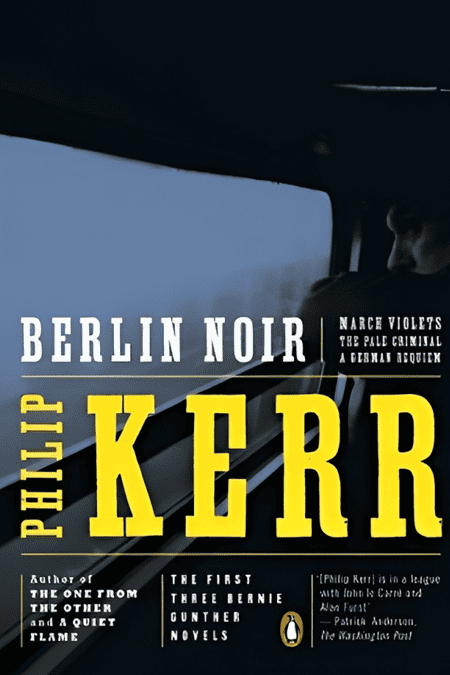
Philip Kerr
First published: January 1, 1993
Setting: Berlin (Germany); Vienna (Austria)
Gun: Walther P38
“Berlin Noir” is a collection of three detective novels by Philip Kerr: “March Violets,” “The Pale Criminal,” and “A German Requiem.” These books follow the character of Bernie Gunther, a former Berlin police officer turned private investigator. Set in the late 1930s and the post-war years, the stories take place against the backdrop of Nazi Germany and the grim aftermath of World War II. In this world, Bernie Gunther navigates a maze of political and social corruption, dealing with Nazis, war criminals, and various other shady characters as he takes on a range of cases that reveal the dark underbelly of society.
The novels are rich with historical detail and dive deep into the ethical complexities of life during a morally compromised era. Bernie Gunther is a cynical, world-weary detective, reminiscent of the hardboiled detectives of American noir fiction, but his setting and circumstances place him in a context far more perilous and morally ambiguous than that of his American counterparts.
In “Berlin Noir,” the Walther gun plays a significant role as an instrument that holds both practical and symbolic power.
Bernie Gunther’s personal preference for the PPK over the P38, despite acknowledging the latter’s reliability, reflects his own complexities as a character. His preference for one gun over another offers insight into his personality and the way he engages with the violent, uncertain world around him. It shows him as a man with specific tastes and convictions, even in the matter of firearms, which adds depth to his character.
The Walther, with its noted association to the SS, also serves as a haunting reminder of the period’s dark history. The gun becomes more than just a tool for self-defense or aggression; it symbolizes the era’s pervasive violence and the moral compromises that characters like Bernie must make to navigate their dangerous world.
In Philip Kerr’s “Berlin Noir,” the Walther gun serves multiple functions: as a practical tool, as a symbol of the era’s dark undertones, and as a reflection of Bernie Gunther’s complex character. It’s more than just a weapon; it’s an integral part of the story’s fabric, accentuating the grim reality and ethical ambiguities of a world on the edge. Including this aspect of the Walther gun will offer a compelling lens through which to explore the role of pistols in famous literary works, particularly in stories that grapple with complicated historical and moral landscapes.

“Walther P38,” I said. “SS hadgrip. I used one myself in the last year of the war. They rattle a bit, but once the unusual trigger pull is mastered you can generally shoot them fairly accurately. I never much cared for the external hammer though. No, I prefer the PPK myself.” I handed back the pictures. “Do you have any of the pathologist’s snaps of the captain?”
And which Walther would you choose? The choice torment is definitely not for us. True collectors have both.We made our miniature Walther P38 in 1:4 scale. The mechanism was adapted for a 2mm pinfire cartridge. It decorated with well detailed wood grips with horizontal notches. As with all our miniguns, we supply it with everything you need for shooting and in a presentable wooden box.

1Q84

Haruki Murakami
First published: May 28, 2009
Setting: Tokyo (Japan, 1984)
Guns: Beretta Model 92
“1Q84” is a complex, multi-layered novel by Haruki Murakami, published between 2009 and 2010. The book features parallel worlds and intertwines the lives of its two main characters, Aomame and Tengo. Set in Tokyo in the year 1984, the novel delves into themes of love, loneliness, and the boundaries of reality.
Aomame is a fitness instructor who moonlights as an assassin targeting men who abuse women. Tengo is a math teacher and aspiring writer. Their paths cross in the most unusual ways as they each become involved with a mysterious religious cult. Aomame starts noticing discrepancies in the world around her and realizes she has entered a parallel universe, which she dubs ‘1Q84,’ where the “Q” stands for ‘question.’ Tengo becomes involved in rewriting a strange novel titled “Air Chrysalis,” authored by a 17-year-old girl, which draws him into the same surreal world as Aomame.
Throughout the narrative, the characters must navigate a reality that increasingly blurs the lines between the mundane and the fantastical, all while dealing with emotional and existential issues.
Beretta Model 92 serves as a perfect microcosm for the atmosphere of “1Q84,” where the boundary between the ordinary and the extraordinary is frequently blurred. The Beretta, a real-world object, is placed within a surreal context, making it emblematic of the novel’s larger themes.
The presence of the Beretta in this fantastical setting serves to ground the narrative in a certain harsh reality. It’s a reminder that, even in a world filled with magical realism and surreal happenings, there are very real dangers and very real tools used to navigate those dangers. Aomame, for instance, uses her weapon as a tool in her vigilante mission, bringing a sense of justice to a world that often seems bereft of it. Her use of the gun signifies both her agency and her desperation to make sense of and “correct” a world that often appears hostile or indifferent.
In a book where the characters struggle with issues of reality and identity, the Beretta serves as a tangible symbol of power and potential violence. It’s a weapon that can bring about change, whether that’s good or bad, and its presence heightens the tension and stakes of the characters’ journey through this strange world.
In “1Q84,” the Beretta handgun serves as more than just a prop. It acts as a grounding object in a narrative filled with surreal and confusing elements. The gun, while a tool of violence, also serves as a symbol of agency and the will to enact change in a confusing and often menacing universe. As such, it would make an interesting addition to your article exploring the role of pistols in famous literary works, offering a unique perspective on how firearms can function in a narrative that blends the real and the surreal.

You know, the usual story. Once upon a time I was playing my harp by a spring when a fairy appeared out of nowhere, handed me a Beretta Model 92, and told me to shoot the white rabbit over there for target practice.
The miniature gun Beretta 92FS has become popular among collectors due to its realistic design and attention to detail. Like our other models, this one also comes with a beautifully crafted wooden box to store the miniature and its accompanying accessories. You will receive a complete set perfect for playing, collecting, or gifting as a memorable present.
The miniature gun Beretta 92FS is a subtle reference to Murakami’s work. It is real, although it is not a real weapon. It shoots, although the cartridges are only 2mm caliber. We have made many variations of the Beretta pistol. And this is the largest version and generally one of the largest pistols that we have made. The scale is 1:3, it feels heavy in the hand. Detailing is also at the maximum. The shutter works as a slider, a movable fuse, the magazine is removed, cocked, the trigger is lowered. It comes with a set of cartridges in a wooden box.
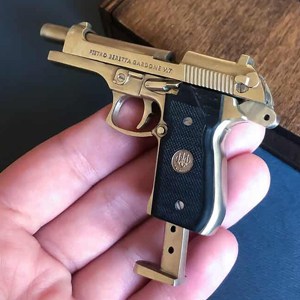
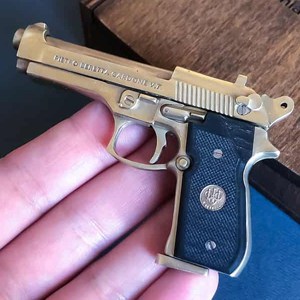
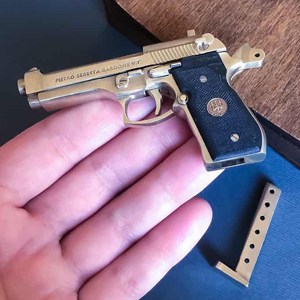
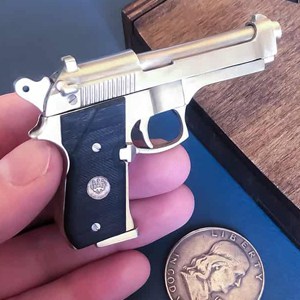
Order the miniature gun Beretta 92FS right now on our website:
About the Author
My name is Olha Polah, and I have been working in miniature weapons production since 2015. I started the mini firearms brand and have been running the brand’s Instagram page since 2016. The brand’s miniatures are popular worldwide, with fans in 25+ countries. I became the sole owner of the brand in 2018 and created a comprehensive line of miniatures. More than 60 models of miniature weapons from various historical periods have been created. In November 2023, I was interviewed by Robert Dunn for the GunTech magazine, where I talked about the hardships I had to endure in my business. I also run a newsletter for the brand’s customers, which has evolved into a full-fledged magazine with in-depth articles published on the wpolah.com.

My mission is to make people’s lives more joyful by sharing interesting facts about miniature weapons and inspiring everyone to express themselves.
